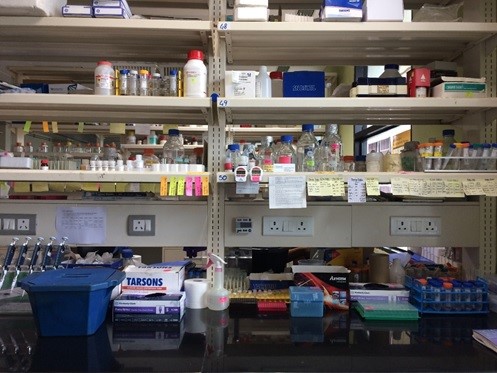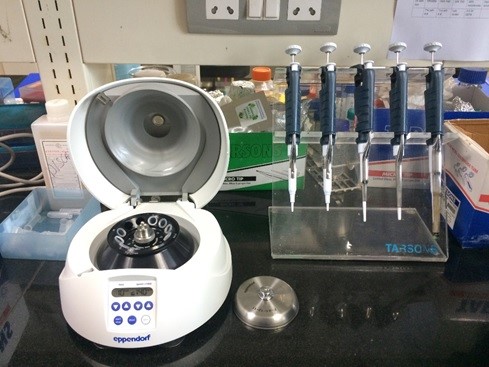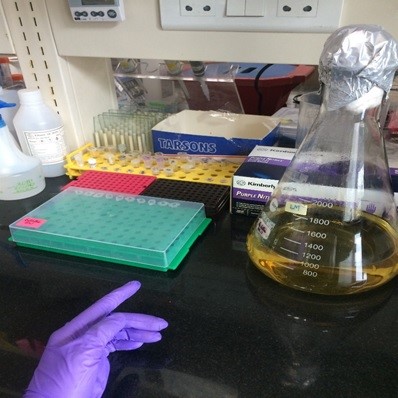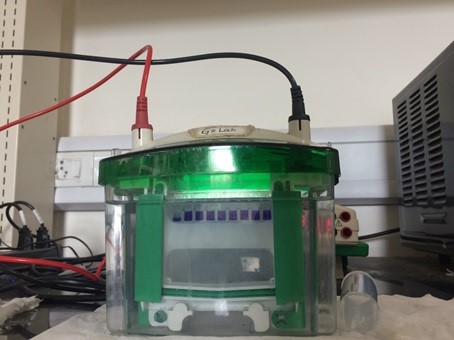Image: In our lab with my mentor, Suthirtha
By Jinpa Palmo
Like every year, Department of Education of the CTA announced scholarships for 10 Tibetan students to spend a month at either National Center for Biological Sciences (NCBS) in Bengaluru or Indian Institute of Science Education and Research (IISER) Pune. I was very happy to have been selected to participate in the internship program at IISER Pune. The internship took place from June 15 and July 15. IISER Pune has a beautiful campus located in a very quiet neighbourhood that is ideal for a serious student.
There were five of us who came from different universities with different academic backgrounds. Each one of us were assigned a supervisor based on our course majors and topics of interest. My topic was about structural biology of bacterial cell and its interaction with other organisms. Accordingly, I was assigned Dr. Saikrishnan Kayarat, from Biology Department. He specializes in structural biology, with his lab focused on the study of different types of restrictions enzymes present in the bacterial cells and its molecular mechanism. Like other organisms, bacterial cells have their own self defence mechanisms. Restriction enzymes play a major role in their self-defence against different foreign molecules such as Bacteriophage. Since there are varieties of restriction enzymes having different functioning mechanisms, Dr. Sai’s students are focused on studying different restriction enzymes.
Dr. Sai assigned me to be mentored by one of his students, Sutirtha. He is working on an enzyme called McrBC complex (Modified cytosine restriction B and C) that is present in E. Coli. This enzyme is mainly made up of two different protein subunits, namely McrB and McrC. Sutirtha is studying how McrC subunit interacts with subunit McrB to act against the foreign DNA. He is trying to find out how these two subunits are dependent on each other in their complex activity.
Usually, many well-studied classical restriction enzymes have methylase subunit that methylates its own (self) DNA sequence and recognises the foreign bacteriophage having unmethylated DNA target sequence. Such restriction enzymes belong to the class of modification independent restriction enzyme. But gradually, bacteriophage also starts methylating their DNA so that such bacterial restriction enzymes are not able to recognise them as foreign DNA due to the new methyl group attached to it, just like in bacterial cells. So, to figure out this new modification by these ‘clever’ bacteriophages, the bacteria comes up with a different type of restriction enzyme that doesn’t have methylase subunit to methylate their own DNA. This keeps their self DNA unmethylated so that they can easily recognise the modified (methylated) bacteriophage DNA as a foreign DNA and thus cleave them. Such enzymes belong to the class of modification dependent restriction enzyme. The enzyme that I am studying, namely McrBC, is one of them.
During the internship, my mentor introduced me to different experimental techniques that he often uses in his own research. He showed me how protein is extracted from the bacterial cells and purified using nickel NTA. We had to check whether we successfully purified our protein by performing SDS PAGE, which helps you check protein expression. We performed three protein purifications and all of them turned out to be successful as they showed successful expressions through SDS PAGE.
I even learned how to prepare gels for the SDS PAGE. My first attempt at making the gel didn’t turn out well due to a mistake I made during the preparation. However, by being careful to not repeat the mistake, I succeeded in the next attempt, and the gel worked very well for running the protein for checking its expression.
I also learned how to isolate plasmid DNA from bacterial cells which can be used for inserting gene of interest in further experiments. In order to check whether proper insertion of DNA stretch in plasmid DNA has occurred, I learned a technique called “double digestion” in which we use two enzymes that can recognise two different restriction sites at each end of our insert and thus cleaving it. We analyse this cleavage on the agarose gel and if you observe two proper clear bands, that indicates successful insertion. We performed plasmid isolation twice, first by Sutirtha and the second one by myself which turned out to have a good concentration.
We even checked the cleavage assay of our protein complex to see if it is cleaving the DNA substrate or not, and to see the effect of its cleavage activity in the absence of one of our protein subunits, McrB or MCRC, and GTP. GTP is necessary for the cleavage activity as a source of energy without which McrBC cannot cleave the DNA substrate. From our observation, in the absence of one of the protein subunits, we were not able to see proper cleavage. But with the presence of both the protein subunit McrB and McrC, we could clearly see two bands on the gels, which confirms proper cleavage activity. Also, without GTP, there is no cleavage activity. But GTP, along with both the protein subunits, McrB and McrC, we could clearly see the cleavage activity. This shows that both the protein subunits and GTP are necessary for cleavage activity.
Besides all the above techniques, I also got to learn other techniques such as “transformation” of bacterial cell which is a method of allowing bacterial cell to take up the plasmid DNA that contains gene of interest. Another technique that I learned is called “inoculation” which is done by allowing the bacterial cells that are grown through transformation to grow in more number in a new liquid media mainly to increase the culture yield. We also performed what is called “inducing”, which is done by mainly inducing the bacterial cell to express its protein so that we could purify that protein and use it in other experiments.
I learned that McrBC is a modification-dependent restriction enzyme that functions by differentiating self and non-self genome based on DNA methylation. They recognise methylated DNA as foreign DNA and thus cleaves them in the presence of GTP. The protein subunit, McrC, that my mentor is studying cannot by itself cleave the DNA substrate. It needs to form a complex with another subunit, McrB, to form a heterooligomeric complex, McrBC. The protein subunits have different functions; McrB is responsible for both DNA binding and GTP hydrolysis while McrC performs endonuclease activity. The GTPase activity of McrB gets activated 30-fold in the presence of its partner, McrB. So, this shows that both the subunits are dependent on each other. The absence of one of them and also the absence of GTP restricts the whole cleavage activity.
Apart from the technical work that I did, I got to experience how research life actually looks. I realised that PhD is not just like a normal degree that we have pursued till now. It is about conducting advanced research by creating your own hypothesis and working on it until you get a result. It is a big commitment in terms of time. You need to be very innovative, patient and hardworking.
Overall, I learned lots of new things from my mentor within this one month.
This internship was very helpful in terms of gaining new knowledge and expanding our academic horizon. I want to thank Department of Education for giving us this wonderful learning opportunity. I am also very thankful to Prachi Madam for being a wonderful guardian who made us all feel very comfortable in a completely new environment. I am also very much grateful to my supervisor, Dr. Saikrishnan Kayarat, for supervising me and assigning me a very good mentor. Lastly, I am indebted to my mentor, Sutirtha. Everything that I learned and experienced within this one month is because of him. He made sure that I understood everything that he taught me.
I would definitely encourage my friends and my juniors to grab this opportunity as they will also learn a lot, just like we did.
More Pictures from the internship:





